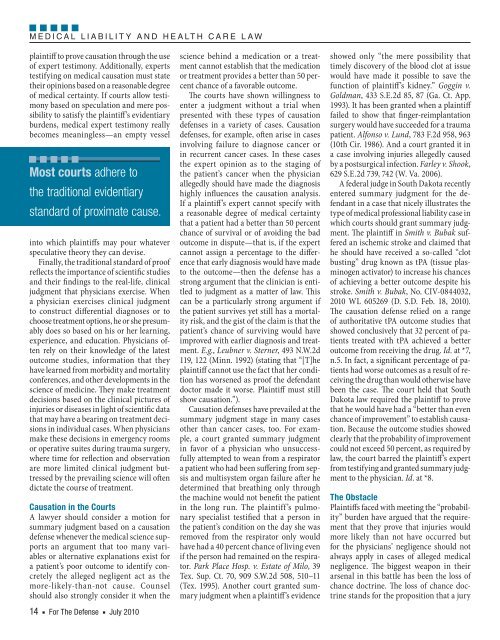For The Defense, July 2010 - DRI Today
For The Defense, July 2010 - DRI Today
For The Defense, July 2010 - DRI Today
- No tags were found...
Create successful ePaper yourself
Turn your PDF publications into a flip-book with our unique Google optimized e-Paper software.
M E D I C A L L I A B I L I T Y A N D H E A LT H C A R E L A Wplaintiff to prove causation through the useof expert testimony. Additionally, expertstestifying on medical causation must statetheir opinions based on a reasonable degreeof medical certainty. If courts allow testimonybased on speculation and mere possibilityto satisfy the plaintiff’s evidentiaryburdens, medical expert testimony reallybecomes meaningless—an empty vesselMost courts adhere tothe traditional evidentiarystandard of proximate cause.into which plaintiffs may pour whateverspeculative theory they can devise.Finally, the traditional standard of proofreflects the importance of scientific studiesand their findings to the real-life, clinicaljudgment that physicians exercise. Whena physician exercises clinical judgmentto construct differential diagnoses or tochoose treatment options, he or she presumablydoes so based on his or her learning,experience, and education. Physicians oftenrely on their knowledge of the latestoutcome studies, information that theyhave learned from morbidity and mortalityconferences, and other developments in thescience of medicine. <strong>The</strong>y make treatmentdecisions based on the clinical pictures ofinjuries or diseases in light of scientific datathat may have a bearing on treatment decisionsin individual cases. When physiciansmake these decisions in emergency roomsor operative suites during trauma surgery,where time for reflection and observationare more limited clinical judgment buttressedby the prevailing science will oftendictate the course of treatment.Causation in the CourtsA lawyer should consider a motion forsummary judgment based on a causationdefense whenever the medical science supportsan argument that too many variablesor alternative explanations exist fora patient’s poor outcome to identify concretelythe alleged negligent act as themore- likely- than- not cause. Counselshould also strongly consider it when the14 n <strong>For</strong> <strong>The</strong> <strong>Defense</strong> n <strong>July</strong> <strong>2010</strong>science behind a medication or a treatmentcannot establish that the medicationor treatment provides a better than 50 percentchance of a favorable outcome.<strong>The</strong> courts have shown willingness toenter a judgment without a trial whenpresented with these types of causationdefenses in a variety of cases. Causationdefenses, for example, often arise in casesinvolving failure to diagnose cancer orin recurrent cancer cases. In these casesthe expert opinion as to the staging ofthe patient’s cancer when the physicianallegedly should have made the diagnosishighly influences the causation analysis.If a plaintiff’s expert cannot specify witha reasonable degree of medical certaintythat a patient had a better than 50 percentchance of survival or of avoiding the badoutcome in dispute—that is, if the expertcannot assign a percentage to the differencethat early diagnosis would have madeto the outcome—then the defense has astrong argument that the clinician is entitledto judgment as a matter of law. Thiscan be a particularly strong argument ifthe patient survives yet still has a mortalityrisk, and the gist of the claim is that thepatient’s chance of surviving would haveimproved with earlier diagnosis and treatment.E.g., Leubner v. Sterner, 493 N.W.2d119, 122 (Minn. 1992) (stating that “[T]heplaintiff cannot use the fact that her conditionhas worsened as proof the defendantdoctor made it worse. Plaintiff must stillshow causation.”).Causation defenses have prevailed at thesummary judgment stage in many casesother than cancer cases, too. <strong>For</strong> example,a court granted summary judgmentin favor of a physician who unsuccessfullyattempted to wean from a respiratora patient who had been suffering from sepsisand multisystem organ failure after hedetermined that breathing only throughthe machine would not benefit the patientin the long run. <strong>The</strong> plaintiff’s pulmonaryspecialist testified that a person inthe patient’s condition on the day she wasremoved from the respirator only wouldhave had a 40 percent chance of living evenif the person had remained on the respirator.Park Place Hosp. v. Estate of Milo, 39Tex. Sup. Ct. 70, 909 S.W.2d 508, 510–11(Tex. 1995). Another court granted summaryjudgment when a plaintiff’s evidenceshowed only “the mere possibility thattimely discovery of the blood clot at issuewould have made it possible to save thefunction of plaintiff’s kidney.” Goggin v.Goldman, 433 S.E.2d 85, 87 (Ga. Ct. App.1993). It has been granted when a plaintifffailed to show that finger- reimplantationsurgery would have succeeded for a traumapatient. Alfonso v. Lund, 783 F.2d 958, 963(10th Cir. 1986). And a court granted it ina case involving injuries allegedly causedby a postsurgical infection. Farley v. Shook,629 S.E.2d 739, 742 (W. Va. 2006).A federal judge in South Dakota recentlyentered summary judgment for the defendantin a case that nicely illustrates thetype of medical professional liability case inwhich courts should grant summary judgment.<strong>The</strong> plaintiff in Smith v. Bubak sufferedan ischemic stroke and claimed thathe should have received a so-called “clotbusting” drug known as tPA (tissue plasminogenactivator) to increase his chancesof achieving a better outcome despite hisstroke. Smith v. Bubak, No. CIV-0844032,<strong>2010</strong> WL 605269 (D. S.D. Feb. 18, <strong>2010</strong>).<strong>The</strong> causation defense relied on a rangeof authoritative tPA outcome studies thatshowed conclusively that 32 percent of patientstreated with tPA achieved a betteroutcome from receiving the drug. Id. at *7,n.5. In fact, a significant percentage of patientshad worse outcomes as a result of receivingthe drug than would otherwise havebeen the case. <strong>The</strong> court held that SouthDakota law required the plaintiff to provethat he would have had a “better than evenchance of improvement” to establish causation.Because the outcome studies showedclearly that the probability of improvementcould not exceed 50 percent, as required bylaw, the court barred the plaintiff’s expertfrom testifying and granted summary judgmentto the physician. Id. at *8.<strong>The</strong> ObstaclePlaintiffs faced with meeting the “probability”burden have argued that the requirementthat they prove that injuries wouldmore likely than not have occurred butfor the physicians’ negligence should notalways apply in cases of alleged medicalnegligence. <strong>The</strong> biggest weapon in theirarsenal in this battle has been the loss ofchance doctrine. <strong>The</strong> loss of chance doctrinestands for the proposition that a jury
















